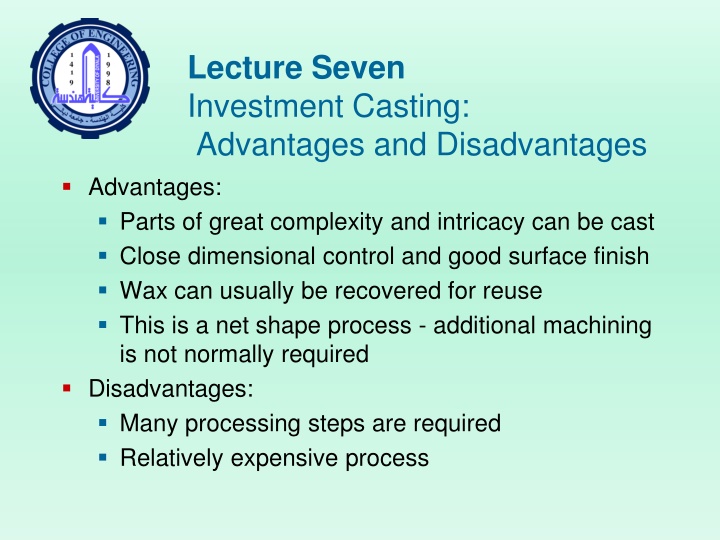
Metal Casting Processes Overview
Learn about investment casting, plaster mold casting, ceramic mold casting, and permanent mold casting processes along with their advantages and disadvantages. Explore the different techniques used in metal casting for creating intricate parts with close dimensional control and good surface finish.
Download Presentation

Please find below an Image/Link to download the presentation.
The content on the website is provided AS IS for your information and personal use only. It may not be sold, licensed, or shared on other websites without obtaining consent from the author. If you encounter any issues during the download, it is possible that the publisher has removed the file from their server.
You are allowed to download the files provided on this website for personal or commercial use, subject to the condition that they are used lawfully. All files are the property of their respective owners.
The content on the website is provided AS IS for your information and personal use only. It may not be sold, licensed, or shared on other websites without obtaining consent from the author.
E N D
Presentation Transcript
Lecture Seven Investment Casting: Advantages and Disadvantages Advantages: Parts of great complexity and intricacy can be cast Close dimensional control and good surface finish Wax can usually be recovered for reuse This is a net shape process - additional machining is not normally required Disadvantages: Many processing steps are required Relatively expensive process
Plaster Mold Casting Similar to sand casting except mold is made of plaster of Paris (gypsum - CaSO4-2H2O) In mold-making, plaster and water mixture is poured over plastic or metal pattern and allowed to set Wood patterns not generally used due to extended contact with water Plaster mixture readily flows around pattern, capturing its fine details and good surface finish
Plaster Mold Casting: Advantages and Disadvantages Advantages: Good accuracy and surface finish Capability to make thin cross sections Disadvantages: Mold must be baked to remove moisture Moisture can cause problems in casting Mold strength is lost if over-baked Plaster molds cannot stand high temperatures Limited to lower melting point alloys
Ceramic Mold Casting Similar to plaster mold casting except that mold is made of refractory ceramic material that can withstand higher temperatures than plaster Can be used to cast steels, cast irons, and other high-temperature alloys Applications similar to those of plaster mold casting except for the metals cast Advantages (good accuracy and finish) also similar
Permanent Mold Casting Processes Economic disadvantage of expendable mold casting: A new mold is required for every casting In permanent mold casting, the mold is reused many times Processes include: Basic permanent mold casting Die casting Centrifugal casting
The Basic Permanent Mold Process Uses a metal mold constructed of two sections designed for easy, precise opening and closing Molds used for casting lower melting point alloys are commonly made of steel or cast iron Molds used for casting steel must be made of refractory material, due to the very high pouring temperatures
Steps in Permanent Mold Casting (1) Mold is preheated and coated for lubrication and heat dissipation
Steps in Permanent Mold Casting (2) Cores (if any are used) are inserted and mold is closed
Steps in Permanent Mold Casting (3) Molten metal is poured into the mold, where it solidifies
Steps in Permanent Mold Casting (4) Mold is opened
Permanent Mold Casting: Advantages and Limitations Advantages of permanent mold casting: Good dimensional control and surface finish Rapid solidification caused by metal mold results in a finer grain structure, so castings are stronger Limitations: Generally limited to metals of lower melting point Simpler part geometries compared to sand casting because of need to open the mold High cost of mold
Applications and Metals for Permanent Mold Casting Due to high mold cost, process is best suited to high volume production and can be automated accordingly Typical parts: automotive pistons, pump bodies, and certain castings for aircraft and missiles Metals commonly cast: aluminum, magnesium, copper-base alloys, and cast iron Unsuited to steels because of very high pouring temperatures
